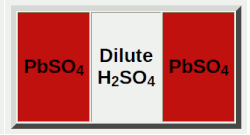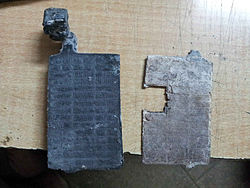Lead acid battery
A lead acid battery is a secondary cell, meaning that it is rechargeable. It is very common in cars and trucks. It contains plates of lead and lead(IV) oxide in a sulfuric acid solution. The lead(IV) oxide oxidizes the lead plate, making an electrical current.
Lead-acid batteries are the cheapest rechargeable batteries and can produce much power. They contain toxic lead, though, and should be recycled. They are wet cells, and the dangerous acid can spill out. Sealed lead acid batteries are batteries where the sulfuric acid is in a gel which stays in, even when the battery is turned up side down.
Reactions:
- lead(IV) oxide + sulfuric acid + extra hydrogen ions → lead(II) sulfate + water at cathode
- lead + extra sulfate ions → lead(II) sulfate at anode
These reactions are reversed when the battery is charged.
Lead Acid Battery Media
A hydrometer can be used to test the specific gravity of each cell as a measure of its state of charge.
Internal view of a small lead–acid battery from an electric-start–equipped motorcycle
Car lead–acid battery after explosion showing brittle fracture in casing ends








